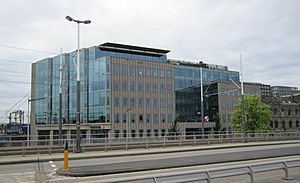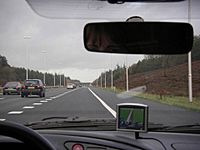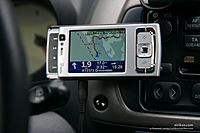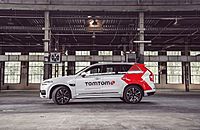TomTom facts for kids
Logo used since 2022
|
|

Headquarter building in Amsterdam
|
|
|
Formerly
|
Palmtop B.V. (until 2003) |
|---|---|
| Naamloze Vennootschap | |
| Traded as | Euronext Amsterdam: TOM2 |
| Industry | Consumer electronics, navigation technology |
| Founded | 1991 |
| Founder | Harold Goddijn Corinne Vigreux Peter-Frans Pauwels Pieter Geelen |
| Headquarters | De Ruijterkade 154, 1011 AC, Amsterdam, Netherlands |
|
Key people
|
Harold Goddijn (CEO), Corinne Vigreux (CMO and co-founder), Taco Titulaer (CFO), Derk Haank (chairman of the supervisory board), Alain De Taeye (management board) |
| Products | devices, digital map, software and services |
| Revenue | |
|
Operating income
|
|
| Total assets | |
| Total equity | |
|
Number of employees
|
4,500 (end of 2019) |
TomTom is a company from the Netherlands that creates cool technology to help people find their way. They make things like GPS devices and digital maps. TomTom started in 1991 in Amsterdam. In 2004, they launched their first GPS navigation devices. By 2019, TomTom had more than 4,500 employees in 29 countries around the world.
Contents
TomTom's Journey: A Brief History
TomTom began in Amsterdam in 1991. It was first called Palmtop Software. The founders were Corinne Vigreux, Peter-Frans Pauwels, and Pieter Geelen. At first, they made software for handheld devices used by businesses.
Later, they started focusing on products for everyday people. In 1996, they released their first software to plan routes on mobile devices. They made a lot of software for Psion devices.
In 1999, Harold Goddijn joined the company. He had already invested in TomTom. In 2001, the company changed its brand name to TomTom. By 2003, its official legal name also became TomTom.
On May 27, 2005, TomTom became a public company. Its shares were listed on the Amsterdam Stock Exchange. This made the company worth almost €50 million.
In 2008, TomTom bought a company called Tele Atlas. Tele Atlas was a big maker of digital maps. This purchase cost TomTom €2.9 billion.
In 2010, TomTom had a famous advertisement. It said, You are not stuck in traffic. You are traffic. This phrase became very popular online.
In 2012, Apple announced that TomTom would provide map data for its new Apple Maps app. This app replaced Google Maps on Apple's iOS 6.
TomTom also started working with car companies. In 2014, they partnered with Volkswagen Group. They researched systems for cars that can drive themselves. TomTom also made deals to put their navigation devices in cars from Volkswagen, Daimler, and Toyota.
In 2015, TomTom expanded its deal with Apple. They also signed a new contract with Uber. Uber's driver app now uses TomTom maps and traffic data in 300 cities worldwide.
In 2018, TomTom released a new device called the TomTom Go Camper. It was made for people who drive caravans and motorhomes.
In 2020, TomTom made a deal with the Chinese company Huawei. Huawei uses TomTom's map data in its Petal Maps service. This service is a replacement for Google Maps on Huawei smartphones.
In June 2025, TomTom announced plans to reduce its global team. This was part of a plan to use more artificial intelligence.
TomTom Products Over Time
Before 1996, TomTom made software for businesses. This included tools for reading meters and barcodes on handheld devices. These devices were like early smartphones.
Later, TomTom focused on software for personal digital assistants (PDAs). Their early mapping software included EnRoute and Citymaps.
By 2001, they released TomTom Navigator. This was their first car satellite navigation software. It changed the company's main focus to GPS car navigation. In 2004, they added a service to update traffic information.
The first all-in-one navigation device was the TomTom Go. It came out in March 2004. This device created a new type of consumer electronics. By 2016, TomTom had sold almost 80 million navigation devices worldwide.
In 2005, TomTom introduced the ability to download new voices for the devices. In 2006, they released the TomTom Rider. This device was tough and water-resistant. It was made for motorcycle riders.
New features came out in 2008. These included IQ Routes, which used average speeds to estimate travel times. They also added "Advanced Lane Guidance." This showed drivers which lane to take.
In 2013, TomTom started making GPS sports watches. These included the TomTom Runner and TomTom Multi-Sport GPS. In 2014, they added a heart rate monitor to the Runner Cardio GPS watch.
In 2015, TomTom launched a new product: the Bandit action camera. It had a built-in media server. This made it easy to share videos quickly.
In 2016, the TomTom Spark sports watch came out. It had GPS, a heart-rate monitor, music, and an activity tracker.
In 2017, TomTom announced it was leaving the consumer sports market. They still supported their existing products. In June 2023, TomTom announced that support for sports watches and other wearable products would stop in September 2023.
In 2018, TomTom became the main supplier of data for Apple's map app.
How TomTom Works
TomTom has two main parts to its business:
- Location Technology: This part provides maps and navigation software to carmakers and other companies.
- Consumer Products: This part sells portable navigation devices and software apps directly to people.
Location Technology for Businesses
TomTom's location technology helps carmakers. Their navigation software is built into cars. It gives current map data, online routes, and guidance. This helps cars predict destinations and find charging points for electric vehicles.
TomTom also sells its location technology to other tech companies. They work with government groups and traffic management companies.
Consumer Products for Everyone
TomTom's consumer business sells portable GPS devices. These devices used to be their main source of income. However, fewer people use standalone GPS devices now. This is because smartphones have built-in navigation apps.
TomTom has changed its focus. They now offer software apps instead of just devices. This change helps them adapt to how people use navigation today.
TomTom's Products and Services
TomTom offers three main types of products: maps, connected services, and navigation software.
TomTom's navigation devices (PNDs) and TomTom GO navigation apps are sold to people directly. They also create in-dashboard systems for cars.
TomTom works with many car manufacturers. They provide built-in navigation systems for these cars.
| Product | Car manufacturer |
|---|---|
| Uconnect | Fiat |
| Blue&Me TomTom | Fiat, Alfa Romeo, Lancia |
| Renault R-Link | Renault |
| Carminat TomTom | Renault |
| Lexus CT MoveOn Navi | Lexus |
| Mazda Navigation System | Mazda |
| Toyota Touch 2 with Go | Toyota |
| Online Traffic Service | Volkswagen |
| Peugeot i-Cockpit | PSA |
| Connect 3D Nav | FCA |
| Gen3,4,5 & 6 | Subaru |
| Gen 2 | Mercury |
| SmartMediaConnect | Smart |
TomTom devices show you the road from a bird's-eye view. They also have a direct overhead map view. They use a GPS receiver to show your exact location. Then, they give you visual and spoken directions to your destination. Some TomTom systems can connect to mobile phones using Bluetooth. This allows them to show traffic congestion maps or even make calls.
TomTom's all-in-one GPS navigation devices have a touch screen, speaker, USB port, and a battery. Most models have Bluetooth. This lets them connect to a smartphone. You can then use the device to make and receive hands-free calls.
- TomTom Go, Via and Start – These are general navigation devices.
- TomTom Camper & Caravan / RV – These models have maps with height and width limits. You can enter your vehicle's size and weight. This helps plan routes that avoid roads too small for your vehicle.
- TomTom Truck – These are for professional truck drivers. They have special software and maps for trucks.
- TomTom Rider – These are water-resistant models for motorcycle and motorscooter users. They have a screen that is easy to use with gloves.
- TomTom One and One XL – The TomTom One is a basic car navigation device. The XL version has a larger touch screen. These models do not have features like Bluetooth hands-free calling.
- Current
- TomTom Go Navigator (formerly TomTom Go Mobile): This is GPS navigation software for Android phones. It replaced an older app. In March 2015, TomTom announced this new app. It offers a "freemium" model. The first 50 miles (75 kilometers) per month are free. This includes all maps, TomTom Traffic, and Speed Cameras.
- TomTom AmiGO (formerly TomTom Speed Cameras): This is a free mobile app released in 2015. It gives turn-by-turn navigation and speed camera alerts. Users can also submit information to help others.
- Former
- TomTom Navigator – This was GPS navigation software for PDAs and some smartphones. It could use built-in or external GPS receivers. Navigator 7 was the last version. It ran on devices using the Windows Mobile operating system.
- TomTom for iOS – This was GPS navigation software for iOS devices like the iPhone and iPad. It was released in August 2009. Apple later stopped supporting older models.
In September 2012, Apple worked with TomTom. TomTom provided map data for Apple's updated Apple Maps app. This was part of Apple's plan to use fewer products from its competitor, Google. TomTom continued to provide data for Apple Maps until 2020.
Support Applications
TomTom Home is a computer program. It lets you update your TomTom device. You can also download new voices or images. TomTom Home is currently on version 2.9.
Newer TomTom models use MyDrive Connect. This program is compatible with Windows and Mac OS X. It helps update the device by downloading files.
Traffic Services
TomTom Traffic is a service that monitors traffic. It uses many sources to get information. This includes data from road sensors and cameras. It also uses traffic flow data from millions of anonymous mobile phone users.
TomTom combines this information. They use special computer programs to improve the data. The system sends updates to TomTom Traffic users every two minutes. The data is never older than 30 seconds. Users can get this service through a built-in SIM card or a smartphone connection.
The system first launched in the Netherlands in 2007. By mid-2011, it was available in many countries. As of 2015, the service had expanded to 34 countries.
- HD Traffic 6.0 (August 2012): This version gave more accurate traffic jam locations. It also improved detection of road closures.
- TomTom Traffic 7.0 (September 2013): This version warned drivers when they were approaching a traffic jam too fast. It also detected road works on highways. TomTom added 'Predictive Flow Feed' to better guess future traffic delays.
- TomTom Traffic 8.0 (November 2014): This version included real-time weather information in its routing. It also warned users about bad weather areas.
Consumer Services
TomTom offers paid services called TomTom Plus. These services warn drivers about speed cameras. They also provide weather updates and traffic alerts.
In October 2008, TomTom released Live Services. These allowed devices to receive updates using a mobile phone network. Services included HD Traffic, Safety Alerts, and Local Search with Google.
On newer TomTom devices, the traffic service is often free. The speed camera service is free for three months on some models. Newer models come with a free lifetime speed camera subscription.
Map Share is a map technology launched in 2007. It lets users make changes to maps on their devices. They can share these changes with others. Drivers can block streets, change traffic direction, and edit street names. They can also add or remove points of interest (POIs).
An online version called Map Share Reporter is on the TomTom website.
IQ Routes uses anonymous travel time data from TomTom users. Newer TomTom devices use this data. They consider the time of day when finding the fastest route. This system is based on actual measured travel times.
Mapping Technology
TomTom has worked with companies like Bosch since 2015. They develop maps for self-driving cars. These maps need to be very precise. They must show details like road features with "precision to the decimeter."
In 2015, TomTom was one of the few independent makers of digital maps. They partnered with brands like Volkswagen to provide maps for the car industry. They also partnered with Uber in 2015 and again in 2020. TomTom maps and traffic data are used in Uber's app. Uber also helps update TomTom's maps.
As part of the Map Editing Partnership (MEP) program, users give feedback on road conditions. This helps update live maps. The program estimates 3 million edits each month.
Apple used data from TomTom for its Maps app since 2012. However, in January 2020, Apple confirmed it was no longer using TomTom data. Apple decided to use its own map framework.
As of 2019, TomTom said 800 million people used its products. This includes hardware and apps. In 2019, TomTom sold its telematics division to Bridgestone. This allowed TomTom to focus more on digital maps and software services.
TomTom also works with the University of Amsterdam. They launched Atlas Lab. This lab researches AI for HD maps used in autonomous vehicles. TomTom develops High Definition (HD) maps for self-driving cars. These maps provide very accurate terrain information.
In early 2020, TomTom announced a deal with Huawei Technologies. Huawei uses TomTom's maps and navigation tools for its smartphones.
TomTom also uses map data from OpenStreetMap. TomTom's vice president of community is a founder of OpenStreetMap.
TomTom collects a lot of data. Their "MoMa" vehicles drive over 3 billion kilometers each year. They use cameras to capture images. This helps them find road changes. TomTom processes about 2 billion map changes each month. They release an updated map database every week.
Who TomTom Competes With
TomTom's main competitors for car navigation devices are MiTAC (which owns Navman and Magellan Navigation) and Garmin.
For maps used in self-driving cars, TomTom's main competitor is Here. Here is owned by a group of German car companies. These include Audi, BMW, and Daimler.
More to Explore
- Azure Maps, which uses TomTom map data and services
- Comparison of commercial GPS software
See also
 In Spanish: TomTom para niños
In Spanish: TomTom para niños





